Projection of Non-Industrial Electricity Consumption in China’s Pearl River Delta under Global Warming Scenarios
Abstract
:1. Introduction
2. Data Sources and Experimental Design
2.1. Data Sources
2.2. Model Description and Experiment Design
2.3. A Non-Industrial Electricity Consumption Model
3. Results and Analysis
3.1. Evaluation of WRF Model Simulation Results
3.2. Changes in Temperature
3.3. Evaluation of the Constructed Non-Industrial Electricity Consumption Model
3.4. Changes in Non-Industrial Electricity Consumption under Future Warming Scenarios
4. Discussion and Conclusions
- The model can simulate the thermal environment characteristics of the Pearl River Delta urban agglomeration well and can simulate the change laws of 2 m temperature and relative humidity. The simulation results have a small deviation from the observation results. The simulation results obtained using the WRFV3.9 model and parameterization scheme are credible, indicating that the model has a good simulation effect for the Yangtze River Delta region.
- The temperatures of various cities in the Pearl River Delta are generally on an upward trend. Foshan and Jiangmen have relatively low ten-year average temperatures, and the temperature change range is relatively small. Huizhou and Dongguan have relatively high ten-year average temperatures, and the temperature change range is relatively large. The warming speed is faster in areas such as Huizhou, Guangzhou, Dongguan, Shenzhen, etc.
- The relationship between electricity consumption and GDP in Guangzhou and Zhuhai is not much different, but Guangzhou is more sensitive to degree days than Zhuhai. The coefficient of degree days in Guangzhou is about seven times that of Zhuhai. At the same time, the electricity consumption of the Pearl River Delta urban agglomeration is negatively correlated with heating degree days.
- Non-industrial electricity consumption in Guangzhou and Zhuhai has a clear trend of continuous annual growth. Under warming scenarios of 1.5/2 °C, electricity consumption in both places has increased, with a significant increase in electricity consumption in Guangzhou, which is about 10 TWh more than the average electricity consumption during historical periods. However, non-industrial electricity consumption in both places has slightly decreased under a warming scenario of 2 °C, with a decrease of about 0.874 TWh.
Author Contributions
Funding
Institutional Review Board Statement
Informed Consent Statement
Data Availability Statement
Acknowledgments
Conflicts of Interest
References
- Zhang, R.-H.; Rothstein, L.M.; Busalacchi, A.J. Origin of upper-ocean warming and El Nino change on decadal scales in the tropical Pacific Ocean. Nature 1998, 39, 879–883. [Google Scholar] [CrossRef]
- Allen, M.; Babiker, M.; Chen, Y.; Zickfeld, K. Summary for policymakers. In Global Warming of 1.5 °C; IPCC: Geneva, Switzerland, 2018. [Google Scholar]
- Cawthorne, D.; de Queiroz, A.R.; Eshraghi, H.; Sankarasubramanian, A.; DeCarolis, J.F. The Role of Temperature Variability on Seasonal Electricity Demand in the Southern US. Front. Sustain. Cities 2021, 3, 644789. [Google Scholar] [CrossRef]
- Ocal, O.; Aslan, A. Renewable energy consumption-economic growth nexus in Turkey. Renew. Sustain. Energy Rev. 2013, 28, 494–499. [Google Scholar] [CrossRef]
- Pardo, A.; Meneu, V.; Valor, E. Temperature and seasonality influences on Spanish electricity load. Energy Econ. 2002, 24, 55–70. [Google Scholar] [CrossRef]
- Han, J.S.; Tan, Z.F. Interpretive Structural Model of Generalized Power System. Autom. Electr. Power Syst. 2008, 32, 42–49. [Google Scholar]
- Tang, Q.; Liu, Y.J. Empirical research on the relationship between energy consumption and economic growth in two periods in China. Sci. Technol. Manag. Res. 2011, 8, 31–40. [Google Scholar]
- Abdrabo, M.A.K.A.; Hassaan, M.A.; Abdelraouf, H. Impacts of Climate Change on Seasonal Residential Electricity Consumption by 2050 and Potential Adaptation Options in Alexandria Egypt. Am. J. Clim. Chang. 2018, 7, 11. [Google Scholar] [CrossRef]
- Erdem, H.H.; Sevilgen, S.H. Case study: Effect of ambient temperature on the electricity production and fuel consumption of a simple cycle gas turbine in Turkey. Appl. Therm. Eng. 2006, 26, 320–326. [Google Scholar] [CrossRef]
- Huang, B.; Zeng, Y.H. Empirical Analysis of the Correlation between Electricity Consumption and Economic Growth. J. North China Electr. Power Univ. 2004, 7, 31–33. [Google Scholar]
- Zhang, C.; Liao, H.; Mi, Z.F. Climate impacts: Temperature and electricity consumption. Nat. Hazards 2019, 99, 14–21. [Google Scholar] [CrossRef]
- Al-Mulali, U.; Ozturk, I.; Lean, H. The influence of economic growth, urbanization, trade openness, financial development, and renewable energy on pollution in Europe. Nat. Hazards 2015, 79, 621–644. [Google Scholar] [CrossRef]
- Auffhammer, M.; Aroonruengsawat, A. Erratum to Simulating the impacts of climate change, prices and population on California’s residential electricity consumption. Clim. Chang. 2012, 113, 1101–1104. [Google Scholar] [CrossRef]
- Liao, S.Y.; Chen, C.C.; Hsu, C.S. The Non-Linear Relationship between Electricity Consumption and Temperature in Taiwan: An Application for STR (Smooth Transition Regression) Model. Mod. Econ. 2018, 9, 587–605. [Google Scholar] [CrossRef]
- Bessec, M.; Fouquau, J. The non-linear link between electricity consumption and temperature in Europe: A threshold panel approach. Energy Econ. 2008, 30, 2705–2721. [Google Scholar] [CrossRef]
- Damm, A.; Kberl, J.; Prettenthaler, F.; Rogler, N.; Töglhofer, C. Corrigendum to “Impacts of +2 °C global warming on electricity demand in Europe”. Clim. Serv. 2023, 4, 31–43. [Google Scholar]
- Yao, J. Electricity Consumption and Temperature: Evidence from Satellite Data. IMF Work. Pap. 2021, 22, A001. [Google Scholar] [CrossRef]
- Tanaka, K.; Matsumoto, K.; Keeley, A.R.; Managi, S. The impact of weather changes on the supply and demand of electric power and wholesale prices of electricity in Germany. Sustain. Sci. 2022, 17, 1813–1825. [Google Scholar] [CrossRef]
- Li, L.; Song, X.; Li, J.; Li, K.; Jiao, J. The Impacts of temperature on residential electricity consumption in Anhui, China: Does the electricity price matter? Clim. Chang. 2023, 176, 26. [Google Scholar] [CrossRef]
- Kpodar, K.R.; Liu, B. The Distributional Implications of the Impact of Fuel Price Increases on Inflation. IMF Work. Pap. 2021, 271, A001. [Google Scholar] [CrossRef]
- Liu, K.; Du, Y.; Chen, W.; Wu, X. Simulation of interaction between high-temperature process and heat emission from electricity system in summer. Glob. Energy Interconnect. 2022, 5, 692–702. [Google Scholar] [CrossRef]
- Tol, R.S.J. The Economic Effects of Climate Change. J. Econ. Perspect. 2009, 23, 29–51. [Google Scholar] [CrossRef]
- Obringer, R.; Kumar, R.; Nateghi, R. Managing the water–electricity demand nexus in a warming climate. Clim. Chang. 2020, 159, 233–252. [Google Scholar] [CrossRef]
- Salehizade, A.A.; Rahmanian, M.; Farajzadeh, M.; Ayoubi, A. Analysis of Temperature Changes on Electricity Consumption in Fars Province. Mediterr. J. Soc. Sci. 2015, 6, 610. [Google Scholar] [CrossRef]
- Zhang, M.; Cheng, C.H.; Ma, H.Y. Projection of residential and commercial electricity consumption under SSPs in Jiangsu province, China. Adv. Clim. Chang. Res. 2020, 11, 131–140. [Google Scholar] [CrossRef]
- Han, W.; Su, J.; Wang, L. Effects of urbanization on human comfort in the Yangtze River Delta. J. Appl. Meteorol. Sci. 2013, 24, 380–384. [Google Scholar]
- Al-Zayer, J.; Al-Ibrahim, A.A. Modelling the impact of temperature on electricity consumption in the Eastern Province of Saudi Arabia. J. Forecast. 1996, 15, 97–106. [Google Scholar] [CrossRef]
- Kasman, A.; Duman, Y.S. CO2 emissions, economic growth, energy consumption, trade and urbanization in new EU member and candidate countries: A panel data analysis. Econ. Model 2015, 44, 97–103. [Google Scholar] [CrossRef]
- Holden, E.; Norland, I.T. Three Challenges for the Compact City as a Sustainable Urban Form: Household Consumption of Energy and Transport in Eight Residential Areas in the Greater Oslo Region. Urban Stud. 2005, 42, 2145–2166. [Google Scholar] [CrossRef]
- Dujardin, S.; Marique, A.F.; Teller, J. Spatial planning as a driver of change in mobility and residential energy consumption. Energy Build. 2014, 68, 779–785. [Google Scholar] [CrossRef]
- Román-Collado, R.; Colinet, M.J. Are labor productivity and residential living standards drivers of the energy consumption changes? Energy Econ. 2018, 74, 746–756. [Google Scholar] [CrossRef]
- Pablo-Romero, M.D.P.; Sánchez-Braza, A.; González-Jara, D. Economic growth and global warming effects on electricity consumption in Spain: A sectoral study. Environ. Sci. Pollut. Res. Int. 2022, 30, 43096–43112. [Google Scholar] [CrossRef] [PubMed]
- Ausloos, K.I. Application of the detrended fluctuation analysis (DFA) method for describing cloud breaking. Phys. A Stat. Mech. Its Appl. 1999, 35, 18–27. [Google Scholar]
- Shameem, M.P.; Villanthenkodath, M.A.; Chittedi, K.R. Economic growth and sectoral level electricity consumption nexus in India: New evidence from combined cointegration and frequency domain causality approaches. Int. J. Sustain. Energy 2022, 41, 1721–1738. [Google Scholar] [CrossRef]
- Jiang, T.; Zhao, J.; Jing, C.; Cao, L.; Wang, Y.J.; Huang, J.L.; Su, B.D.; Wang, R. Projection of population changes in China and its provinces under the IPCC Shared Socioeconomic Pathways. Prog. Clim. Chang. Res. 2017, 13, 128–137. [Google Scholar]
- Li, H.J.; Ma, H.Y.; Lin, Y.T.; Liang, Y.X. Numerical simulation of the impact of urban group heterogeneity on regional heat island effect in the Yangtze River Delta. Meteorol. Sci. 2019, 39, 194–205. [Google Scholar]
- Chen, L.; Ma, Z.; Li, Z.; Wu, L.; Flemke, J.; Li, Y. Dynamical Downscaling of Temperature and Precipitation Extremes in China under Current and Future Climates. Atmos.-Ocean. 2018, 56, 55–70. [Google Scholar] [CrossRef]
- Tian, W.W.; Huang, Z.Y.; Hu, C.J. Research on climate warming and urban heat island in Xi’an. J. Appl. Meteorol. Sci. 2006, 17, 438–443. [Google Scholar]
- Aroonruengsawat, A.; Auffhammer, M. Impacts of Climate Change on Residential Electricity Consumption: Evidence from Billing Data. NBER Chapters 2011, 52, 666–673. [Google Scholar]
- Kim, H.G. Effects of Climate Change on Electricity Consumption: A Decomposition of Industrial, Residential, Agricultural, And Commercial Sectors. Clim. Chang. Econ. 2021, 12, 2150014. [Google Scholar] [CrossRef]
- Duan, H.L.; Qian, H.S. Responses of the electric power consumption to climate change in Guangzhou city. J. Appl. Meteorol. Sci. 2009, 20, 80–87. [Google Scholar]
- Carraro, C.; Massetti, E. Energy and climate change in China. Environ. Dev. Econ. 2012, 17, 689–713. [Google Scholar] [CrossRef]
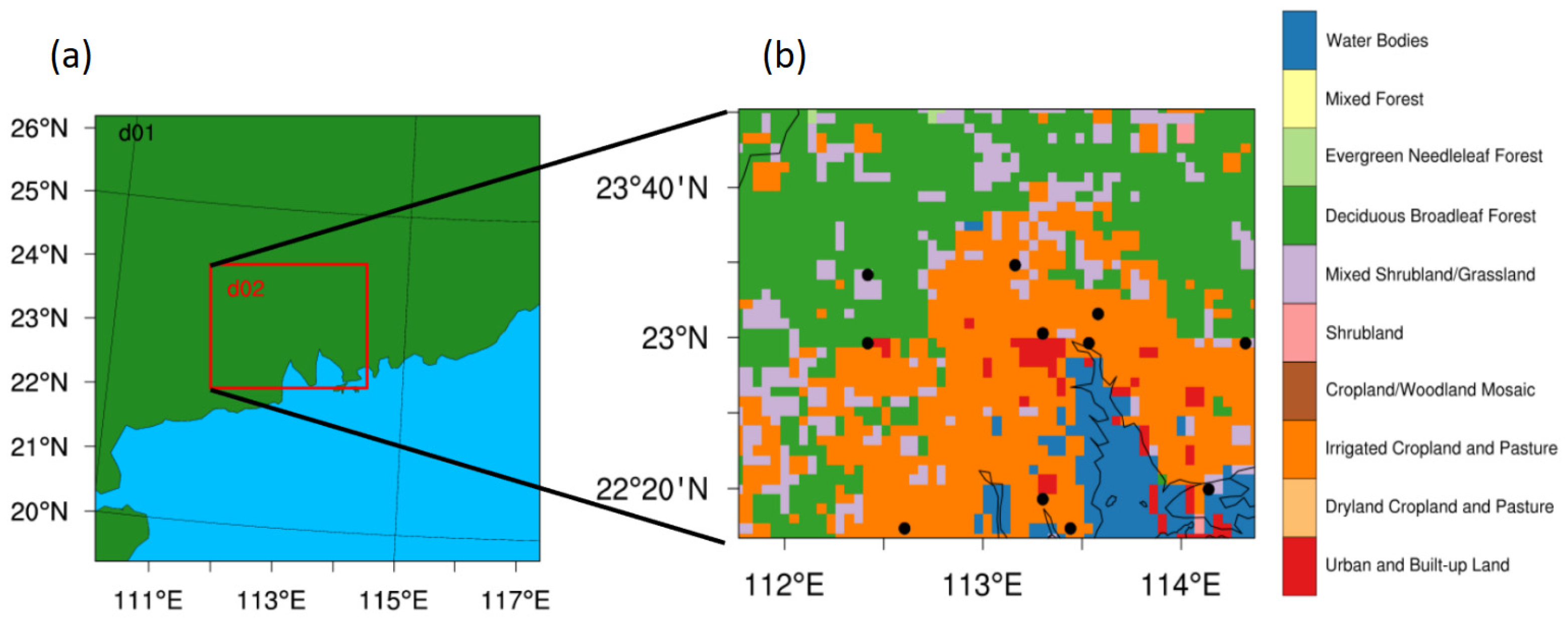
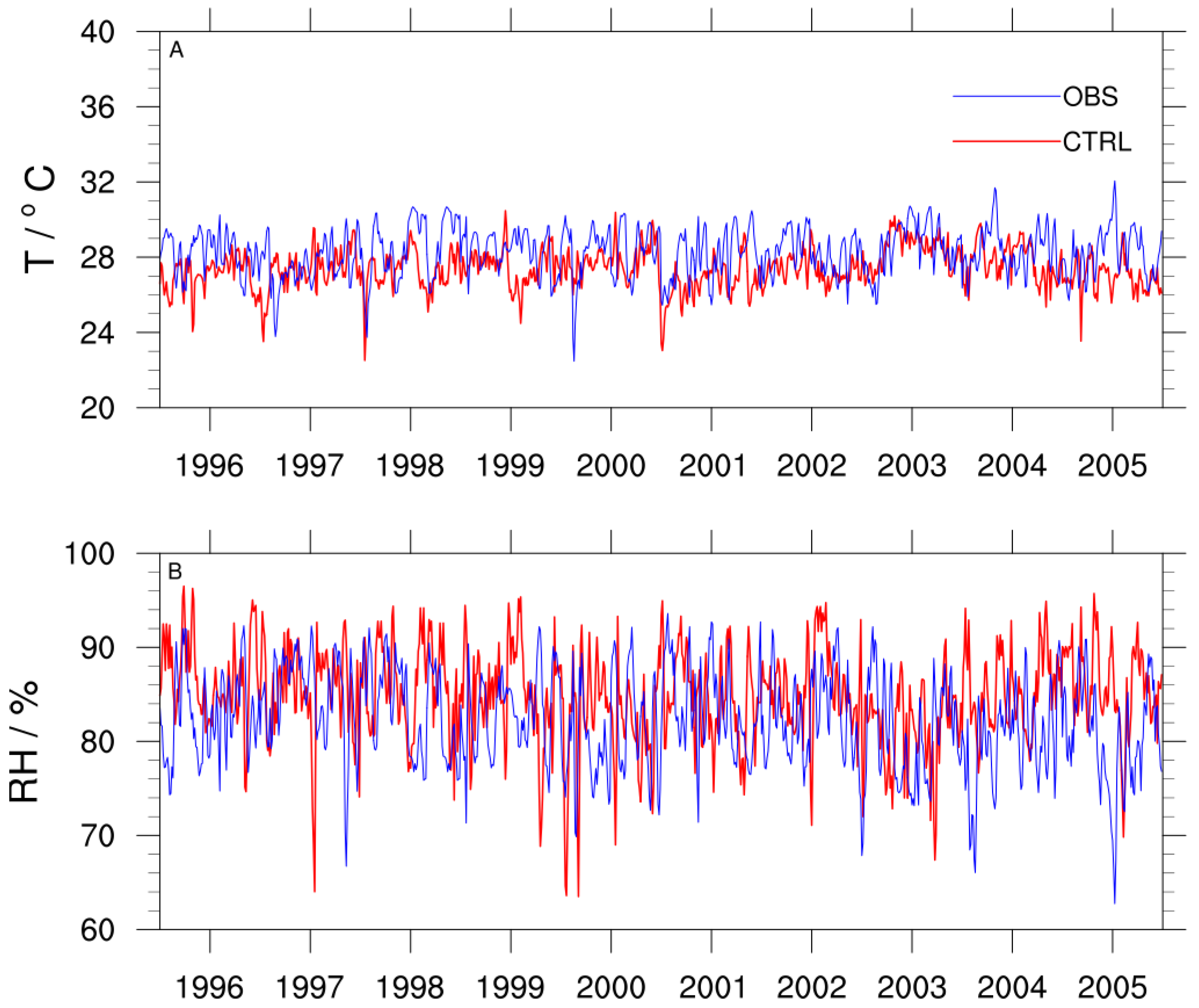
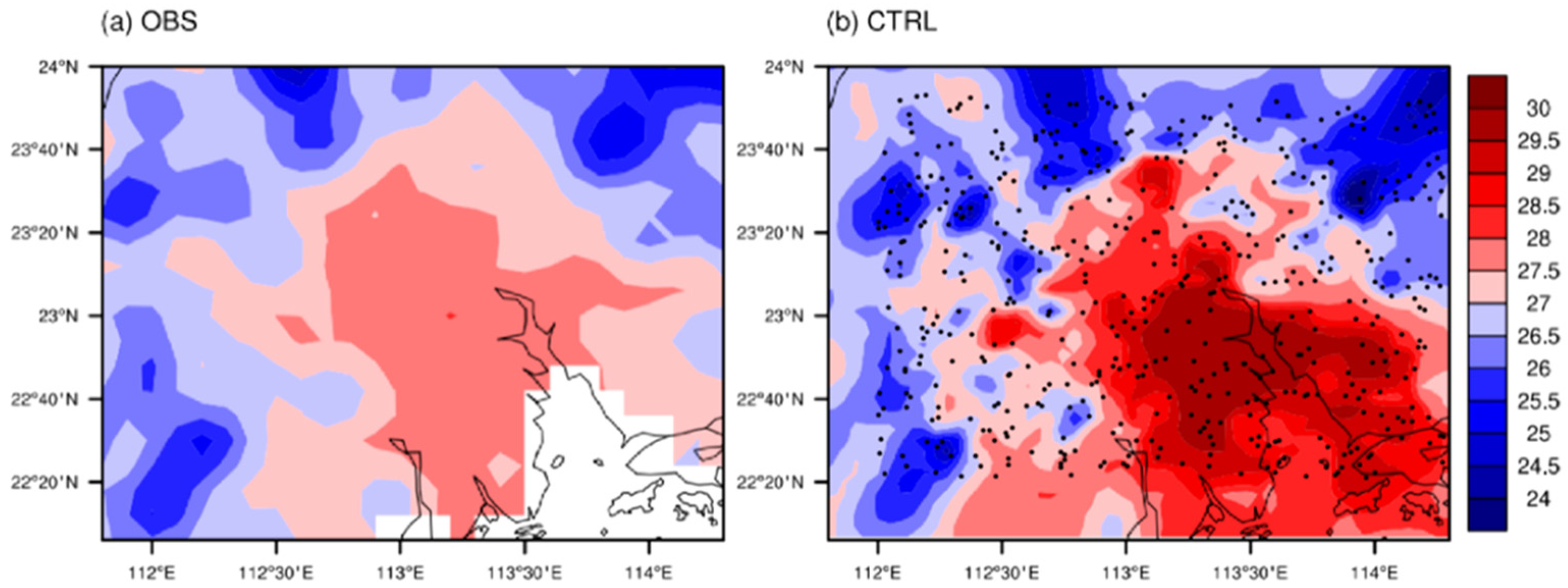


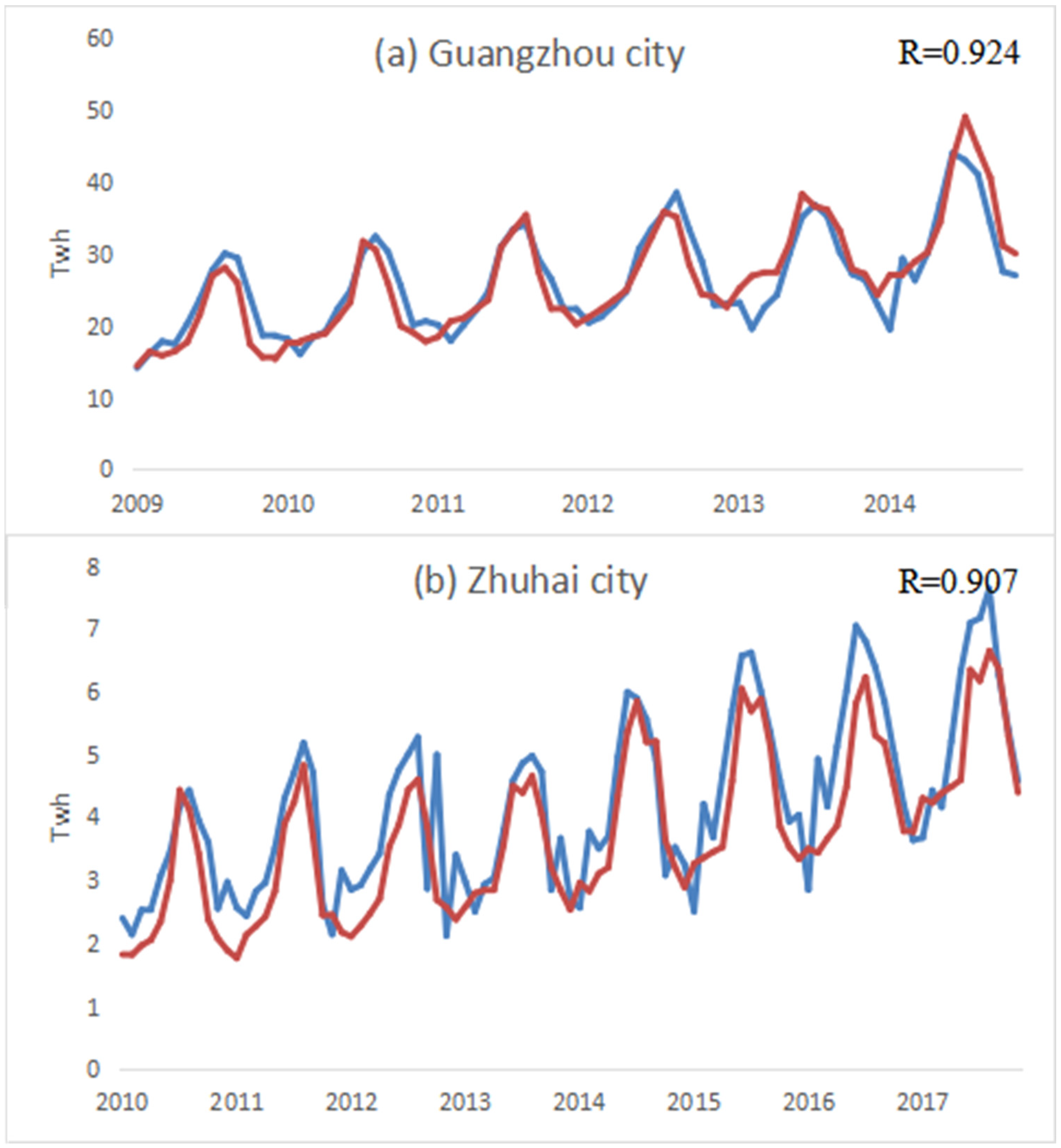
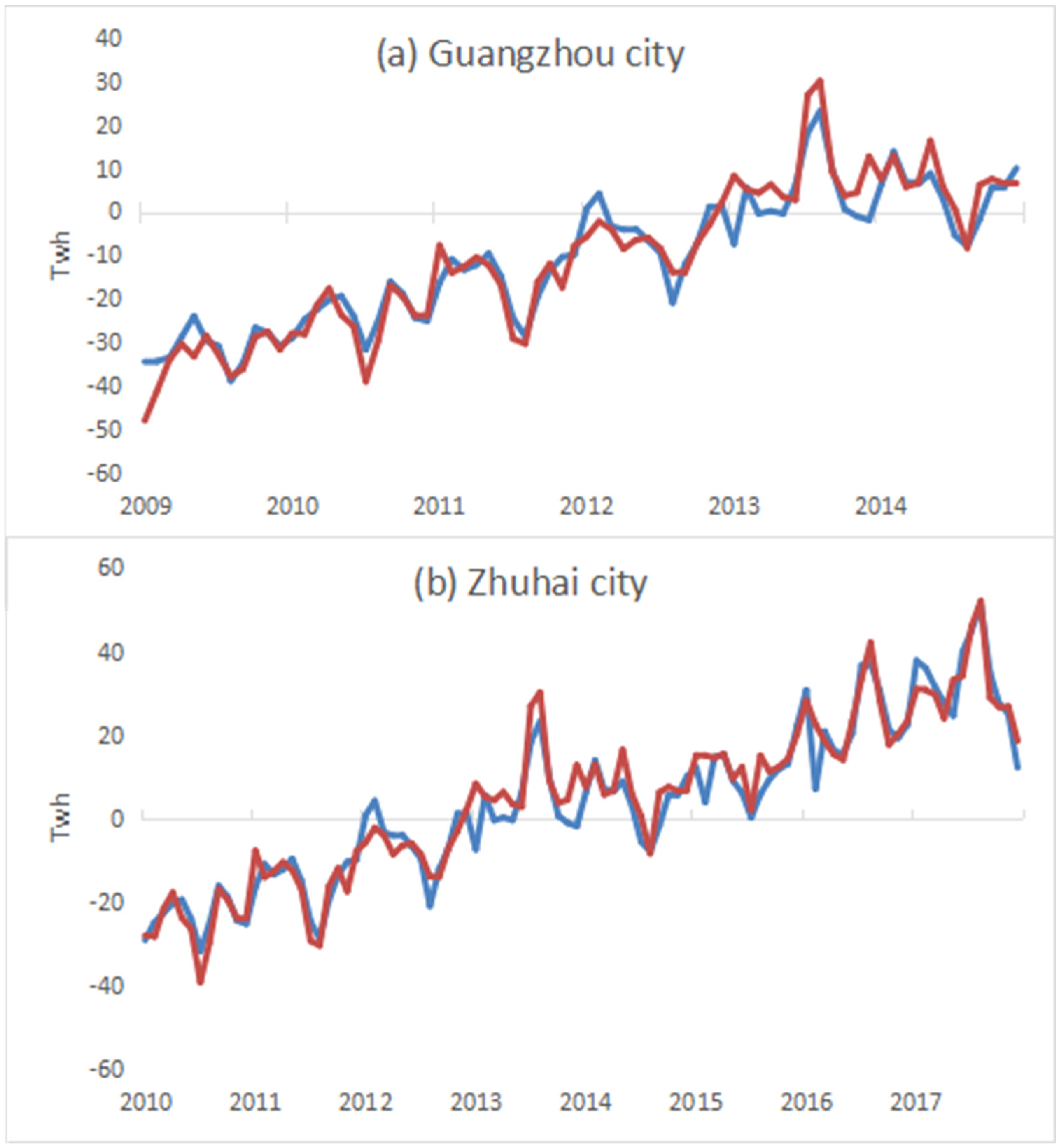
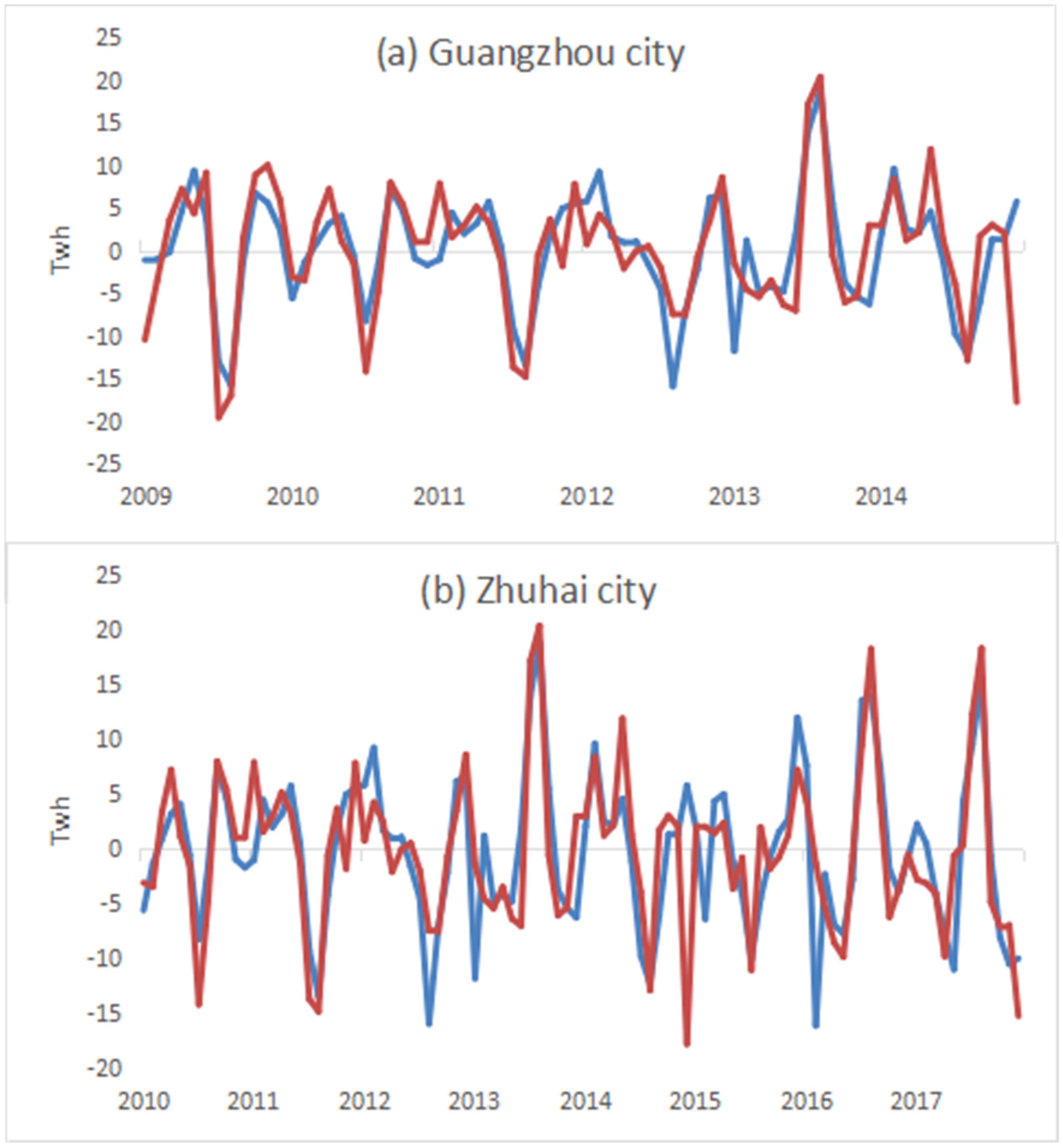
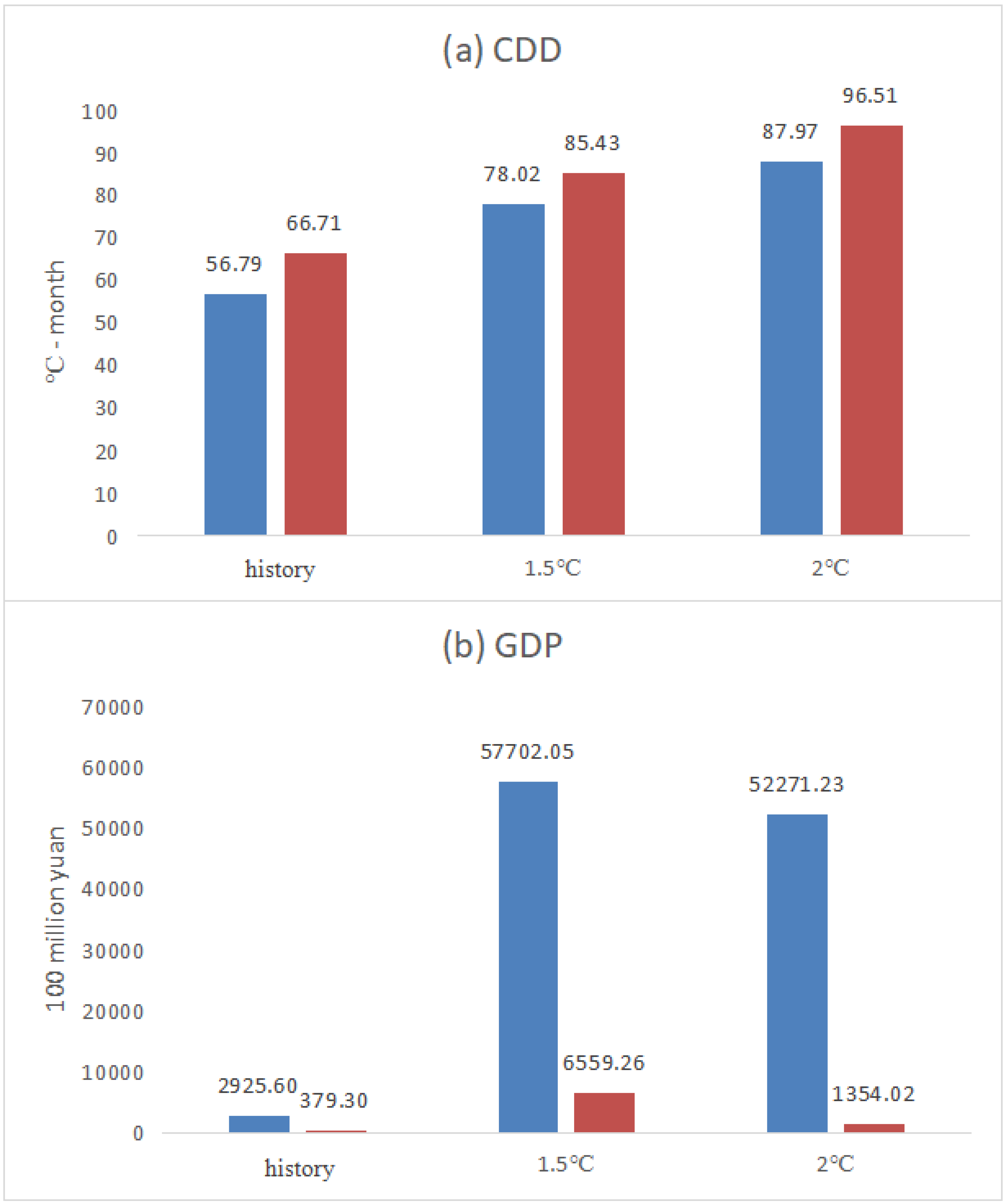

| R | ||||
|---|---|---|---|---|
| Guangzhou city | 0.0018 | 0.137158 | −0.024598 | 0.924 |
| Zhuhai city | 0.001725 | 0.021855 | −0.003403 | 0.907 |
| History | 1.5 °C | 2 °C | |
|---|---|---|---|
| CDD (°C·month) | 56.76 | 78.02 | 87,97 |
| GDP (100 million yuan) | 2925.60 | 57,702.05 | 52,271.23 |
| electricity consumption (TWh) | 13.06 | 114.57 | 106.15 |
Disclaimer/Publisher’s Note: The statements, opinions and data contained in all publications are solely those of the individual author(s) and contributor(s) and not of MDPI and/or the editor(s). MDPI and/or the editor(s) disclaim responsibility for any injury to people or property resulting from any ideas, methods, instructions or products referred to in the content. |
© 2024 by the authors. Licensee MDPI, Basel, Switzerland. This article is an open access article distributed under the terms and conditions of the Creative Commons Attribution (CC BY) license (https://creativecommons.org/licenses/by/4.0/).
Share and Cite
Li, T.; Tao, L.; Zhang, M. Projection of Non-Industrial Electricity Consumption in China’s Pearl River Delta under Global Warming Scenarios. Sustainability 2024, 16, 2012. https://doi.org/10.3390/su16052012
Li T, Tao L, Zhang M. Projection of Non-Industrial Electricity Consumption in China’s Pearl River Delta under Global Warming Scenarios. Sustainability. 2024; 16(5):2012. https://doi.org/10.3390/su16052012
Chicago/Turabian StyleLi, Tiaoye, Lingjiang Tao, and Mi Zhang. 2024. "Projection of Non-Industrial Electricity Consumption in China’s Pearl River Delta under Global Warming Scenarios" Sustainability 16, no. 5: 2012. https://doi.org/10.3390/su16052012






